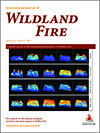International Journal of Wildland Fire
Volume 30
Number 9 2021
This investigation addressed the effects of wearing a standard wildland firefighter helmet compared with a commercially available vented helmet on the accumulation of heat and work capacity. It was found that the vented helmet allowed more work to be performed, possibly as the result of better maintenance of the helmet microenvironment.
This research aims to simulate wildfire propagation using a GIS-based cellular automata model that considers the most effective spatial and temporal drivers of wildfire propagation including wind speed and direction, vegetation type and density, and topographic conditions; wind speed and direction were assumed changeable over the simulation.
We use airborne lidar data to examine how wildfire severity influences the horizontal and vertical connectivity of fuel in temperate eucalypt forests. Our study provides evidence of positive feedbacks to flammability and a greater potential for crown fires through increased ladder fuels after high-severity fire.
The flammability and thermal behaviour of dead and live Eucalyptus saligna leaves before ignition are studied. The results indicate that the flammability of dead and live leaves cannot be solely assessed by moisture content. The external heat flux and fuel moisture content govern thermal behaviour before ignition.
Forest fires are important disturbances that influence accurate estimates of forest carbon budgets. This paper calculates burning efficiencies of fuels across different strata grouped by fire severities and by forest types and estimates carbon emissions produced from eight forest fires. Effects of environmental factors on fuel burning efficiency are also discussed.
A novel concept of fire growth to describe and interpret the non-monotonic or intermittent growth of a fire over the course of time due to the interaction between the fire, the fuel and the surrounding environment is proposed. Experimental fires in slopes and canyons are used to support the concept.
An impulse current generator was used to study artificial lightning ignition. A 10/350 μs impulse current could ignite a cotton fibre bed and produce sustained and stable combustion. An artificial lightning ignition model of the fuel bed was developed.





